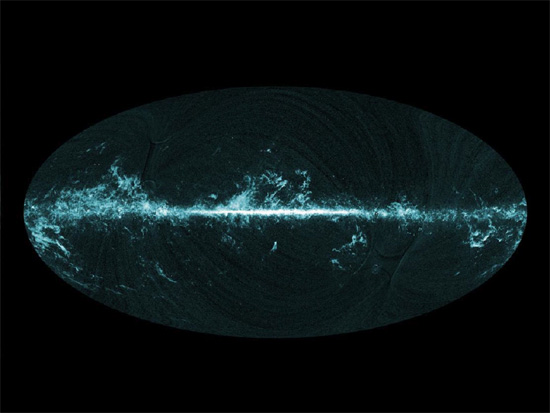Feb 11, 2013
Astronomers continue to cling to outmoded theories of star formation
The European Space Agency (ESA) launched the Planck telescope platform on May 19, 2009 into an orbit around Lagrange point L2. Planck is designed to analyze the cosmic microwave background radiation (CMBR) with greater precision than its predecessors. Foreground radiation that is said to interfere with precise measurements will be subtracted from the CMBR data, revealing “…its encoded information about what our universe is made of, and the origin of its structure.”
One of the sources of foreground radiation is cold clouds of molecular hydrogen that are thought to be where stars are born. Since hydrogen clouds in deep space are close to absolute zero (-273.15 Celsius), they are not easy to detect. What Planck does is to choose another molecule that radiates with greater intensity: carbon monoxide. Astronomers think that carbon monoxide was mixed in as clouds of hydrogen accumulated through gravitational attraction.
Prevailing theories state that the Universe began as a sea of undifferentiated energetic “particles” in a creation event known as the Big Bang. There was once nothing, which subsequently exploded into everything. How or why this happened is not explained, nor can it be.
Despite the irony inherent in the claim, it was when the explosion expanded and cooled that substantive particles supposedly came into existence. Those particles included protons and electrons that then combined into what we know as matter, primarily hydrogen gas. Since hydrogen is composed of one proton and one electron, it is thought to be one of the first atoms, along with helium. So where did the carbon monoxide come from?
According to consensus theories, primordial hydrogen and helium immediately began to coalesce into vast “stellar nurseries”, where whirlpools of gas condensed into spherical shapes. Those spheres grew hotter and hotter as the atoms within them increased their motion. Finally, the compression became so intense that their cores ignited into thermonuclear fires. This theory is known as the Nebular Hypothesis, originally proposed by Pierre Simon de Laplace in 1796.
Astrophysical theories argue that, as those Population One stars fused their hydrogen into heavier elements, their cores became unstable due to ever greater concentrations of more massive atoms. Once a star accumulates enough thermonuclear “ash”, it undergoes a catastrophic implosion, since nuclear reactions can no longer keep gravitational contraction at bay. The star’s outer surface collapses inward at tremendous speed, rebounding off the dense core material. The star then erupts outward in a supernova explosion, blasting its outer layers into space.
Carbon and oxygen are said to exist because they were forged in the core fires of the earliest stars. Therefore, carbon monoxide in our galaxy exists because innumerable Population One stars have exploded throughout the Universe for uncounted eons, scattering their debris over millions of light-years.
Astrophysicists continue to ponder the mystery of why some stars accrete more mass during their gestation than is theoretically possible. Since the collapsing cloud of gas that gave them birth is supposed to generate more radiation as it condenses than its structure can survive, the shell of gas around them ought to blow away before sufficient matter can condense.
The most likely reason that protostars do not obey conventional theory is that they are not what astronomers think they are.
The Electric Star hypothesis presumes that the role of plasma and electric fields in space is far more relevant to the data than kinetic activity (heated gas). The radiant emanations that Planck observes result from electric currents.
What Planck sees are dusty, filamentary clouds containing charged ions called plasma. Moving clouds of plasma generate electric currents within each other. Whenever electric current flows through plasma the current spirals into filaments, which attract each other. However, due to short-range repulsion of their electromagnetic fields, rather than merging they spiral around one another in “Birkeland current” pairs.
As the energy density increases, the filaments enter “glow mode”, while the magnetic flux density draws matter from the surrounding space. Eventually, they form a number of glowing globes of plasma like “beads on a string.”
It is in this way that stars are born. Gravity is a weak force when compared to an electric field and ionized particles. Although it does play a role in stellar evolution—drawing ions to one side of a plasma cloud, for example—electricity is the stellar progenitor and not gravity.
Stephen Smith













